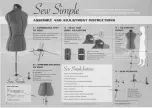
40
—
—
—
—
—
—
—
—
—
—
—
—
—
—
—
—
—
—
—
—
—
—
—
—
—
—
—
—
—
—
—
—
—
—
—
—
—
—
—
—
—
—
—
—
—
—
—
—
—
—
—
—
—
—
—
—
—
—
—
—
—
—
—
—
—
—
—
—
—
—
—
—
—
—
—
—
—
—
—
—
—
—
—
—
—
—
—
—
—
—
—
—
—
—
—
—
—
—
—
—
—
—
—
—
—
—
—
—
—
—
—
—
—
—
—
—
—
—
—
—
—
—
—
—
—
—
—
—
—
—
—
—
—
—
—
—
—
—
—
—
—
—
—
—
—
—
—
—
—
—
—
—
—
—
—
—
—
—
—
—
—
—
—
—
—
—
—
—
—
—
—
—
—
—
—
—
—
—
—
—
—
—
—
—
—
—
—
—
—
—
—
—
—
—
—
—
—
—
—
—
—
—
—
—
—
—
—
—
—
—
—
—
—
—
—
—
—
—
—
—
—
—
—
—
—
—
—
—
—
—
—
—
—
—
—
—
—
—
—
—
—
—
—
—
—
—
—
—
—
—
—
—
—
—
—
—
—
—
—
—
—
—
—
—
—
—
—
—
—
—
—
—
—
—
—
—
5
■
When stretch blind hem stitching
When stretch blind hem stitching using the blind
stitch foot, turn the screw to adjust the guide to the
folded hem.
• For more details on blind hem stitching, see
page 30.
1
Screw
2
Guide
3
Folded hem
Satin stitches
Various decorative stitches can be obtained by sewing
with the Satin Stitch when following the instructions
below.
a
Lower the needle into the fabric at the
beginning of the stitching.
b
Start sewing.
• For details, refer to “Starting sewing”
(Page 23).
c
Sew satin stitches while adjusting the
stitch width by turning the pattern
selection dial slowly in the range shown in
the table below.
Note
●
Be sure to turn the pattern selection dial
only within the specified range.
d
When sewing is finished, cut the thread.
• For details, refer to “Starting sewing”
(Page 23).
1
2
3
Needle
Available stitch width (
)
Pattern sewn
Available stitch
length
Single
0.5-5
0-1 (F)
Twin
0.5-3
5
0.5
3
0.5
















































